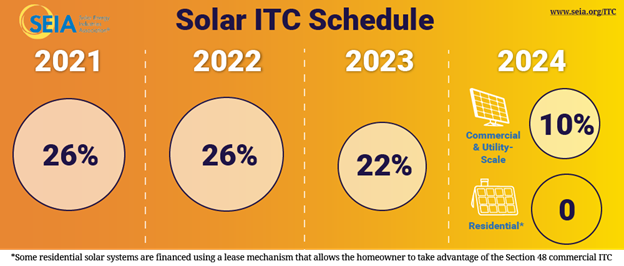One year into the coronavirus, what have we learned? It’s been a year since COVID-19 turned our lives upside down. With the end of the pandemic in sight, we’re looking back at how the coronavirus has changed us and updating three lessons we learned early on in the crisis: security starts at home; safe investments pay you back; and the climate crisis is still ahead of us. Because the global tragedy of the pandemic is just a dress rehearsal for the even bigger global calamity of climate change…and the lessons we learned in the pandemic can help us prepare.
Security starts at home
In our post a year ago, we observed how “social distancing” had become a watchword of the pandemic, and that finding security starts at home. Mindful of this “new normal,” Solaflect has followed the guidance and limited face-to-face interactions. And while we can’t wait to mix it up again at farmers’ markets, renewable energy events, and public events in general once we’re all allowed to gather again, we plan to carry on some of the remote-work practices that we adopted early in the pandemic.
One of these is incorporating on-line meetings over Zoom to cut down on our own carbon footprint – and leaving more time to be on-site when we’re really needed. This “work from anywhere” culture is not entirely new at Solaflect. We’ve long had a “digital connection” with our customers. Thanks to remote sensors and internet relays, we’ve always been able to keep close tabs on the performance of our solar Tracker installations. Now that same technology makes it possible for our customers to assume more control over the entire process – from on-line meetings over Zoom, to programming the actual flow of solar power into home appliances, batteries and the grid, once our installation is complete.
The recent Texas power outage is yet another painful reminder of the need to get this set-up right. Millions of Texans were left to shiver in the dark because they had no access to reliable back-up power when their grid went down. Worse, the Texas grid itself hasn’t been properly weatherized, and it’s still not ready for the large influx in solar and wind power that accounts for nearly all new capacity additions in Texas. That leaves the Lone Star state still vulnerable to more climate-related disasters in the years to come.
So, if COVID-19 taught us that security starts at home, the Texas power outage reminds us that this security can’t be outsourced to the grid. For a 21st century home to be truly secure, it must always have access to a safe and reliable on-site power that will keep critical home appliances and internet communications up and running. As we said in our post a year ago:
Solar power – especially when connected with battery storage, electric vehicles and domestic heat pumps – keeps our energy supply chain right at home and under our control. Whether it’s storm-related power outages, cyber-attacks on the grid, or shelter-in-place emergencies, home-based solar power ensures that we will always have access to safe, affordable and reliable electricity.
Safe investments pay you back
A year ago, as the coronavirus was shutting down large chunks of our economy and the stock market was crashing – we were reminded just how risky and volatile these investments can be. Yet, through it all, solar power continued to generate rock-solid returns for homeowners intent on saving on their utility bills. (The same goes for EV owners who want to save at the gas pump.)
The beauty of renewables is that they operate without incurring fuel costs – making them a good hedge against volatile price swings in broader energy markets. At the same time, falling capital costs have made wind and solar the lowest-cost forms of power generation at utility scale. Solar is also fast becoming the most economical way to power our homes and vehicles as well. A two-year extension of the federal solar investment tax credit – at 26% through 2022, and 22% in 2023 – means this more affordable price trend will continue. Home battery systems also qualify for these credits when they’re connected to solar arrays.
And solar power and battery manufacturing costs continue to fall, so the economics of our home energy systems keep getting better. But there’s no need to wait. When you invest in solar today, you’re locking in profits over the next 25 years. As we said in original post last March:
Our Solar Trackers take roughly 10 years, depending on your utility and sun at home, to pay back at present, after factoring in the current 26% federal tax credit. The remaining decade and a half of their operating lives generate what some call “pure profit.” (Others just think it’s just the right thing to do, no matter how the numbers add up!)
The climate crisis still awaits us
COVID-19 hit in the last year of four years of U.S. retreat from a range of pressing global issues, including our withdrawal from the Paris climate accord in 2017. Yet, despite these headwinds, the momentum behind green energy continues to mount. Solar and wind power have become the fastest growing energy resources in the U.S., and have created more jobs than any other sector of our economy since 2016. Sadly, the United States is now among a majority of parties to the Paris agreement that have not yet updated their plans to limit global warming to 1.5 degrees Celsius.
Even countries that have submitted these plans – representing about 30% of today’s global warming emissions – are falling well short of the cuts that are really needed. In sum, their contribution is expected to shrink the global carbon footprint by only 0.5% from 2010 levels by 2030. By comparison. the Intergovernmental Panel on Climate Change estimates that a 45% cut in global carbon emissions will be required altogether over the period if the world is to have a decent shot of staying under the 1.5°C warming limit.
In that sense, lessons from COVID-19 line up perfectly to address the urgency of the global warming challenge. It starts with embracing science – even when it presents an “inconvenient truth” about the scope of the problems we’re facing – and taking early action before worst-case scenarios materialize. As we said in our post a year ago:
Solar power, in effect, acts like a vaccine to help keep the earth’s temperature from rising. The more solar we inject into the global energy system now, the more we will be able to flatten the warming curve and make the world a better and safer place for ourselves and future generations.
We’re All in this Together
No matter what, we’re all in this together. Notably, our response to COVID-19 introduced us to the concept of “essential workers” — health care and nursery-home workers, grocery-store clerks, emergency responders and others, whose contributions keep our economy from breaking down. Many of these front-line workers are immigrants and people of color who work for minimum wages and don’t have access to affordable health care. If the coronavirus exposed these inequities in our social safety net, climate change is revealing the fallibilities in our outdated, command-and-control approach to power generation, which could compound the suffering of many if the grid fails to come grips with today’s new energy landscape.
It does not have to be that way. By democratizing energy ownership with omnipresent wind and solar resources – and by switching to electric vehicles and using smart apps to configure our daily energy needs – we are finally starting to shift the balance of power in our nation’s energy system in favor of consumers. As we’re fond of saying at Solaflect Energy, “The power is in our hands to make a difference!”
Now, the biggest obstacle in getting this carbon-free vaccine into the veins of our economy is a transmission bottleneck that’s still not prepared for the massive influx of widely dispersed renewables coming its way. It follows that we need an infrastructure plan to build out a 21st century grid that can accommodate a lot more wind and solar – and be able to transmit this green power over long distances via high-voltage power lines. President Biden is about to introduce an infrastructure bill that makes this greening of the grid a top priority. But it’s still only part of the solution. We also need a grid that looks downstream and deepens its ties within communities.
So, one year into the COVID-19 tragedy, the lights may finally be turning from red to green. And so should it be with our nation’s power supply – switching from red-alert fossil fuels to a green energy wave that’s just starting to crest. Science has given us the wake-up call. Technology is giving us the tools to respond. And the markets are now giving us the proper price signals to act. As the coronavirus finally starts to wind down, there’s no time to lose!
Solaflect is your home energy management partner. We help you install clean and affordable solar electricity and battery systems for a more resilient and climate-friendly future. Click here to contact us, email info@solaflect.com, or call (802)649-3700, or text (802)308-3018. Working together, the power is in our hands to make a difference!







